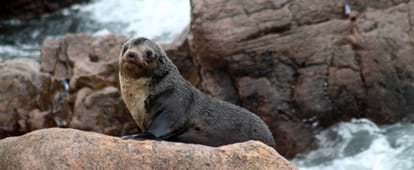By creating an account, I agree to the
Terms of service and Privacy policy
Choose your country and language:
Africa
Americas
Asia Pacific
Europe
GGreat white sharks breaching – leaping high in the air before smashing back down into the water – has been witnessed almost exclusively around Seal Island in False Bay, south-east of Cape Town. This spectacular form of hunting – by a species currently listed as ‘vulnerable’, one step away from ‘endangered’ – is now a tourism drawcard.
The first footage of great whites breaching took the world by storm. For some, though, this premeditated hunting behaviour made the shark an even more formidable predator than they had imagined. Sadly, the cliché that ‘any publicity is good publicity’ has never applied to great white sharks – not since the horror film Jaws.
More than 40 years after the worst – and most inaccurate – publicity campaign any wild creature has endured, great white sharks’ vulnerable status is an indication that they are still struggling to shed their reputation as man-eating predators prowling the oceans maliciously.
On a boat tour to see the sharks breaching in False Bay, you’ll discover that quite the opposite is true. If you are extremely fortunate, you’ll get to see a shark as long as 3.8m – that’s the combined height of two tall men – launch out of the water as it deploys its unique hunting technique.

BBaby Cape fur seals are the food source that cause these remarkable aerial gymnastics at dinner time. Located about 5km offshore, Seal Island is home to more than 60 000 seals. In winter, when game fish are scarce, seal pups become the great white’s meal of choice. The shark’s lunge out the water is part of a surprise attack that starts deep beneath the surface.
Seal Island appeals to sharks for more than its ‘all-you-can-eat’ buffet during the pupping season. A sharp 25m drop-off from the island gives the predators the perfect launch pad for their attack. Camouflaged against the sea bottom by its colouration (great whites have a white belly and grey back), the shark swims in a rapid upward trajectory with speeds often exceeding 40km/h.
It’s the final lunge that takes the shark somersaulting out of the water, sometimes as high as 3 metres into the air. In about half the attacks, though, the shark doesn’t catch the seal: many pups escape using their incredible underwater agility.
If you’re interested in marine wildlife and you’re in Cape Town at the right time of year, taking a boat tour to watch the great whites feeding – and perhaps treating you to an aerial display – is an unforgettable once-in-a-lifetime experience.
Be aware, though, that in the past few years the number of great white sharks feeding around Seal Island, and the frequency of their visits, has declined; scientists are not yet sure why. As a result, encounters with these magnificent but threatened creatures are never guaranteed.
TTravel tips & Planning info
Who to contact
Apex Shark Expeditions
Tel: +27 (0)21 786 5717
Email: info@apexpredators.com
Simon’s Town Tourism Office
Tel: +27 (0)21 786 8440
Email: info@capetown.travel
How to get here
From the airport, take the N2 (Cape Town) turn-off. Take the M3 (Muizenberg) turn-off to the right, and head south for about 20km. At the T-junction, turn right towards Ou Kaapse Weg. Cross one set of traffic lights and take the Simon’s Town/Ou Kaapse Weg road left. This road will take you over the mountain, past the train station and into the centre of Simon’s Town.
Best time to visit
The best time to see great whites at Seal Island – although sightings are never guaranteed, especially in recent years – is from mid-April to mid-September, when baby Cape fur seals are abundant.
Get around
You can reach Simon’s Town by car or by train. If you do not have a hire car, metered taxis or Uber will get you from your accommodation to the harbour for your tour.
Around the area
Being the primary base of the South African Navy, all things maritime are popular in Simon’s Town. Visit the beach, the harbour and the museums, sail, dive, fish, sea kayak, whale watch and don’t leave without visiting the town’s cutest residents: the African penguins of Boulders Beach.
Tours to do
There are museum tours, harbour tours, historic walking tours and even a mine tour in Simon’s Town.
What will it cost?
Shark encounter tours cost from approximately R2 600 per person.
What to pack
All your dive gear is supplied as well as a light lunch and beverages. Wear flat shoes with a good grip, and take a warm, weatherproof jacket for the boat ride. False Bay seas can be choppy, so if you suffer from sea-sickness, take the necessary medication prior to your trip.
Where to stay
Tours depart from Simon's Town harbour, so make this quaint fishing village and naval base your home from home. Choices range from camping, caravan parks and backpackers to 4-star hotels.
What to eat
Seafood restaurants with fabulous views abound in Simon’s Town, but for something special visit the Boulders Beach Restaurant and feast on Pacific-rim cuisine just metres from the famous Boulders penguin colony; or dine onboard a museum ship, the CS Cable Restorer. There’s a wicked patisserie in town too.
Best buys
Souvenir hunters will find naval-themed art, shells and gemstones at Mineral World.
Related links

